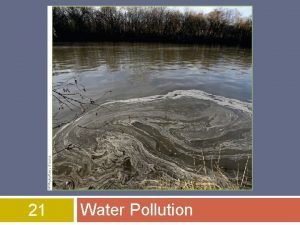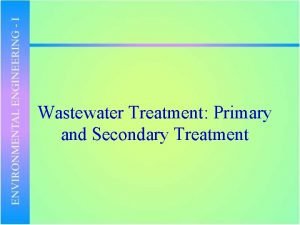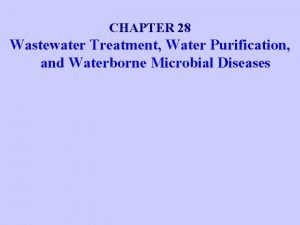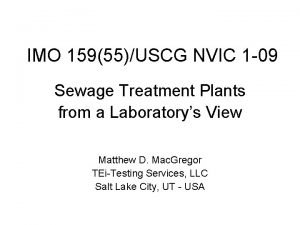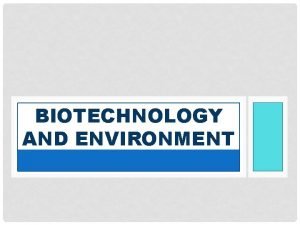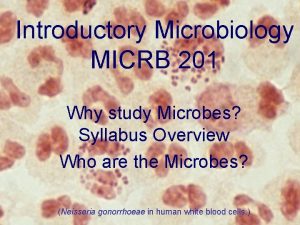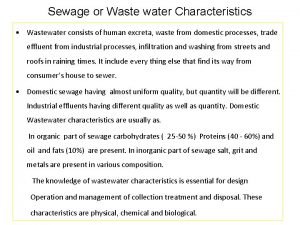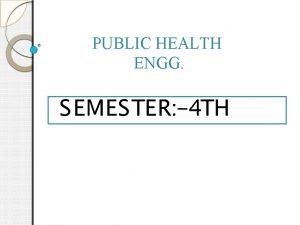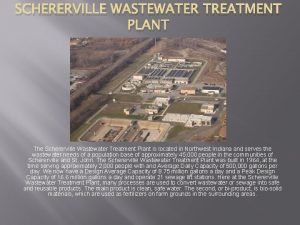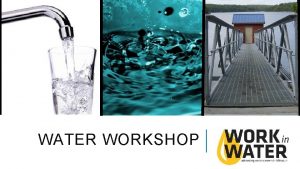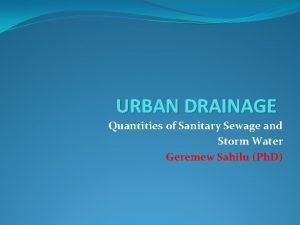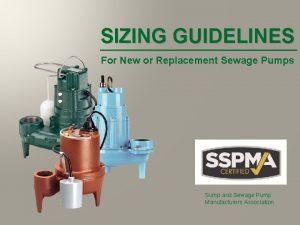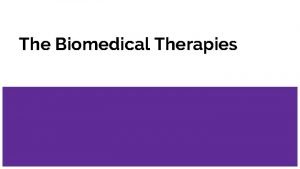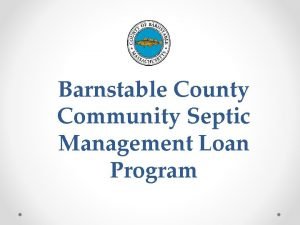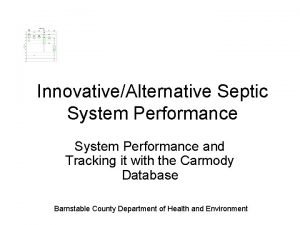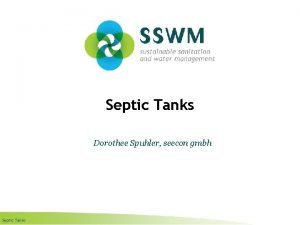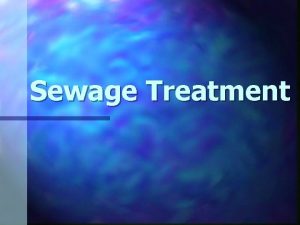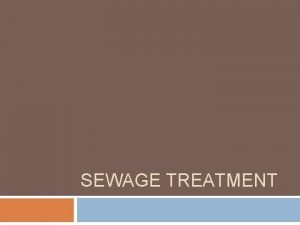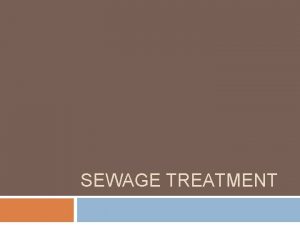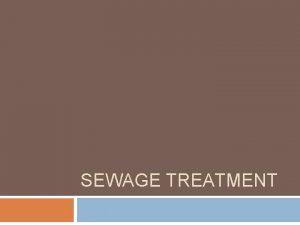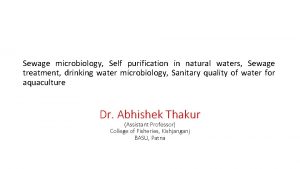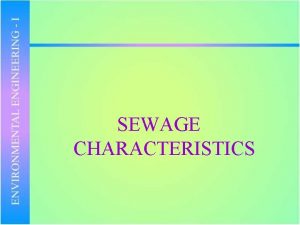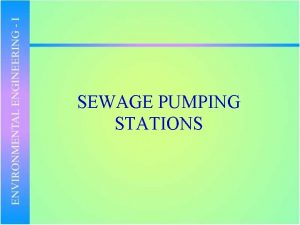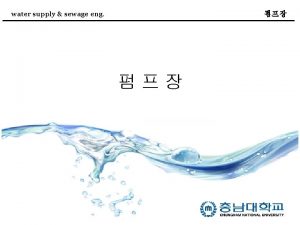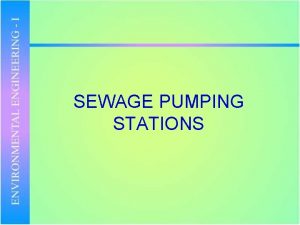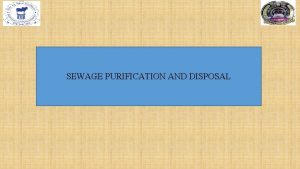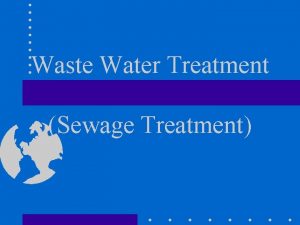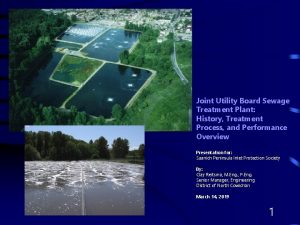Sewage Treatment SEPTIC TANKS Septic tanks are used


















- Slides: 18

Sewage Treatment

SEPTIC TANKS Septic tanks are used in areas where there are no combined sewers. Septic tanks (cesspools) must be emptied each year. Old tanks can crack and leak coliform bacteria into surrounding soil, groundwater, and surface waters.

Figure 9 -28 Page 196 Septic tank with manhole (for cleanout) Household wastewater Non-perforated pipe Distribution box (optional) Gravel or crushed stone Drain field Vent pipe Perforated pipe

Sewer Systems Sewage systems collect water from homes to one central location to be treated. Sewage is kept separate from collected rainwater. Rainwater goes straight to rivers and lakes. NOT TREATED

SEWAGE TREATMENT • Sewage treatment means cleaning waste water before returning it to the watershed. • Sewage treatment separates solids from liquids by physical processes and purifies the liquid by biological and chemical processes

PRIMARY TREATMENT First large solids are screened out of the water. ○ Bags, toys, hygiene products, etc. ○ Fats, oil, and grease (fog) is skimmed off the top as well. ○

PRIMARY TREATMENT ○ Liquid is then sent to settling tanks for sand, grit, and small particles to settle out.

SLUDGE TREATMENT ○ Sludge is an excellent soil conditioner and is used as a fertilizer on farmland.

SECONDARY TREATMENT ○ Microorganisms are used to break down dissolved organic material in the water.

SECONDARY TREATMENT ○ This process can be sped up by pumping air into the water to provide oxygen. ○ These treatment units are called aeration tanks. .

Primary Bar screen Raw sewage from sewers Grit chamber Secondary Settling tank Aeration tank Settling tank Chlorine disinfection tank To river, lake, or ocean Sludge Air pump (kills bacteria) Sludge digester Sludge drying bed Disposed of in landfill or applied to cropland, pasture, or rangeland

TERTIARY TREATMENT ○ Water is disinfected before leaving the treatment plant to kill any pathogens. ○ Chlorine ○ UV Light ○ Ozone

POLLUTION FROM SEWAGE • Carries disease-causing agents (cholera bacteria, hepatitis, E. coli. • Causes nutrient-loading (organically-rich) into surface waters. • Causes an increase in BOD (biological oxygen demand), which causes a decrease in dissolved oxygen

IMPACTS FROM ORGANIC WASTE 8 ppm Types of organisms Dissolved oxygen (ppm) Biological oxygen demand 8 ppm (mg/L) ne Clean Zo n Septic Zone itio Decompos Zone s ater organism w n a le c l a Norm , bass, (Trout, perch tonefly) Recovery Zone Fish absent, Trash fish h s fi Trash fungi, sludge (carp, gar, worms, leeches) ) s e h leec bacteria Clean Zone s ater organism w n a le c l a Norm , bass, (Trout, perch fly) mayfly, stone

Mock Essay a) Describe the major differences between Primary and Secondary sewage treatment. b) What are some of the ways that organic wastes are broken down during secondary treatment? c) During the final stages of water treatment, describe one infectious agent and a method used to remove or kill it. d) Describe one type of solid material removed from waste water and what is done with it following treatment. e) Describe the two effects of untreated (or poorly treated) sewage discharge on local waterways.

WATER POLLUTION CONTROL LAWS 1988 – Ocean Dumping Ban Act – barred ocean dumping of sewage sludge at the 200 mile marker. All cities were in compliance by 1988 EXCEPT for NYC, who were permitted to dump until June, 1992. 1972 – Water Pollution Control Act – EPA established regulations for the discharge of pollutants in the USA. It gave the EPA authority to implement pollution control programs and set ambient water quality standards for all contaminants entering surface waters. It also funded the construction of sewage treatment plants.

WATER POLLUTION CONTROL LAWS ○ The Federal Water Pollution Control Act was amended in 1977 and came to be known as the Clean Water Act. The ACT does NOT address water quantity or groundwater, ONLY water quality. Initially addressed point source, since the 1980’s has come to address nonpoint source issues as well.

Homework Create a virtual tour of a wastewater treatment plant. (prezi or powerpoint) Include… 1) Each step of treatment 2) How each step cleans the water 3) Pictures of each step
 Antigentest åre
Antigentest åre Water treated from sewage treatment plant
Water treated from sewage treatment plant Grit chamber function
Grit chamber function Primary settling
Primary settling John martinko
John martinko Conclusion of wastewater treatment ppt
Conclusion of wastewater treatment ppt Ce certification sewage treatment
Ce certification sewage treatment Sewage cleanup hanahan
Sewage cleanup hanahan Sewage sickness
Sewage sickness Characteristics of wastewater
Characteristics of wastewater Ce certification sewage drainage water pump
Ce certification sewage drainage water pump Conservancy and water carriage system
Conservancy and water carriage system Local guide program
Local guide program Sewage water
Sewage water Dwf and wwf
Dwf and wwf Sewage pump sizing
Sewage pump sizing The biomedical treatment most widely used today is
The biomedical treatment most widely used today is Barnstable septic loan
Barnstable septic loan Nitrex
Nitrex

